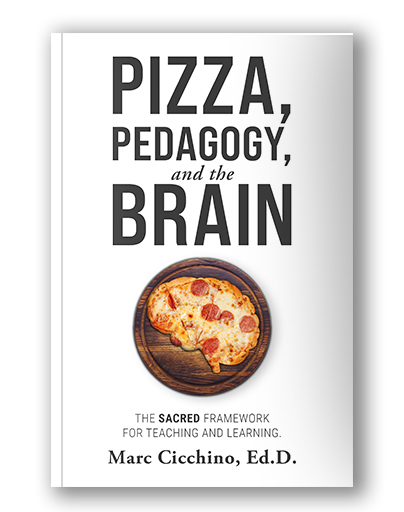Looking for brain based teaching strategies? Look no further!
If you’re on the hunt for brain based teaching strategies, you’re likely already familiar with the incredible effects that this kind of brain-informed instruction can have on your students. That said, if you’re looking for a good place to start, you might want to check out Pizza Pedagogy and the Brain: The SACRED Framework for Teaching and Learning, as well as the corresponding online PD.
In summary, the truth is that any instructional strategies can be considered brain based teaching strategies as long as they align with, or are used in a manner that aligns way, the current research on how we learn.
Here’s what I mean by that. When project-based learning was first developed, a brain scientist wasn’t using a blueprint of how memories are formed to drive the methodology. When the first KWL chart was sketched out on a chalkboard, it wasn’t necessarily with neuroscience in mind. But that doesn’t mean that these strategies (or, parts of these strategies) aren’t congruent with how our brains learn.
Educators have historically developed and honed classroom strategies that work “because they do.” We have long been guided by helpful learning theories, but when it comes down to it, we often shape our practices based on what we can sense (or can quantify) is working in our classrooms, with our kids.
It just so happens that the most effective of these strategies are, more likely than not, brain based teaching strategies. And those that aren’t are likely either ineffective, or less effective than we know they can be.
If that makes you wonder why on earth EVERYONE isn’t educated on the neuroscience of learning, and why brain based teaching strategies aren’t the default mode of teaching for educators everywhere… well, I ask myself that question every day. So let’s get to it.
Three Brain Based Teaching Strategies That Are Proven To Enhance Learning
Rather than to provide an exhaustive list of brain based teaching strategies (which would require hundreds of pages), we’re going to focus on three of the most effective brain based techniques for forming durable, long lasting memories. (If you’re hungry for something more exhaustive, consider checking out Pizza, Pedagogy, and the Brain, where every chapter is brimming with practical strategies — or Zaretta Hammond’s Culturally Responsive Teaching and the Brain, which explicitly applies the principles of brain based learning to instructional contexts that benefit culturally and linguistically diverse learners.)
Strategy #1: Use the Test Itself as a Vehicle for Learning
This is a proven phenomenon that is widely referred to as “the testing effect” in the neuroscience and education literature. In short, we now understand that when students exert effortful recall (such as when they’re challenged to answer questions correctly on a test), they actually strengthen the neural pathways associated with those memories.
In essence, the test ITSELF becomes a powerful vehicle for learning.
It’s especially important to realize that in order for this effect to occur, all that’s truly necessary is effortful retrieval on the part of your students. It might be called “the testing effect,” but it works just as well with any kind of activity that prompts effortful thinking. Tests and quizzes work, but so do other formative assessment tasks, warm-ups, reflections, and ungraded activities.
Strategy #2: Use Time To Your Advantage
The second of our brain based teaching strategies takes advantage of what is known as “the spacing effect.” Research has shown that learning necessitates time (and sleep) to be consolidated into memory. The opposite of this strategy is “cramming” – studying as much as possible in a single night. But we often do the same thing with our curricula – cramming as much content as we can into a single unit, or a single lesson, instead of purposefully introducing it and giving it time for consolidation.
Another important facet of this effect is how it integrates nicely with the testing effect. As time elapses and our memories (the stuff we’ve learned) collect some dust, they become more challenging to recall. That effortful recall, in turn, strengthens those neural pathways and cements those memories. Review your pacing guide and lesson plans to strengthen retention with time on your side!
Strategy #3: Use the Interleaving Effect to Plan Your Instruction
The third of our brain based teaching strategies has finally begun making its way into some popular curricular platforms (often described as a “spiral” curriculum), but is still less widely known than it should be. This strategy is interleaving, and like its cousins (the testing effect and the spacing effect), the interleaving effect shows that learners retain more (and learn more) when the content they’re learning is mixed-up rather than massed.
For example, if someone were learning to drive, massed practice might look like practicing left turns for an hour, practicing stopping at stop-lights for an hour, and practicing changing lanes for an hour. Interleaved practice, on the other hand, would look like spending that time doing a combination of all of those things. The end result might leave the learner feeling less like they mastered the skill, but in the end, the learner will have a comparatively better grasp across the board. Interleave the knowledge and skills you want your students to master, and revisit the timing of your lessons to support that pursuit!
More Brain Based Teaching Strategies & Practical Examples
If you’re eager to learn more about what makes these brain based learning strategies actually work (the scholarly research behind the principles), and if you’re hungry for many more brain-based learning strategies with concrete examples you can practically use with your classes, check out Pizza Pedagogy and the Brain: The SACRED Framework for Teaching and Learning. Or, if you’d prefer to learn all about brain-based learning through video tutorials and love the thought of printable, editable handouts that make use of these strategies, check out the corresponding online PD.


